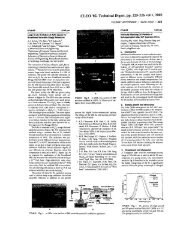Otto H. Zinke - University of Arkansas Physics Department
Otto H. Zinke - University of Arkansas Physics Department
Otto H. Zinke - University of Arkansas Physics Department
You also want an ePaper? Increase the reach of your titles
YUMPU automatically turns print PDFs into web optimized ePapers that Google loves.
Bulletin <strong>of</strong> the American Physical Society, v 20, Issue 4, p 645-645, 1975-ture is wide, the corrected resistivity is indeed proportionalto T except for small effects. The the&expansion should axso oont ribute to the deviation fromMatthiessen'a rule. The effect will be most pronouncedfor solids <strong>of</strong> high melting temperature and should alsonpply to other transport properties, including the latticethermal conductivity.'isupported by the U.S. Axmy Research Office - Durham.EP 8 Blectronic Properties <strong>of</strong> Metals at Low but Finite'Temperatures* David Y. Kojima (introduced by Isihars) andA. Isihara, State U. <strong>of</strong> N. Y. at Buffalo.--Based on agrond ensemble method, the electronic internal energy,specific heat and susceptibility have been evaluated moateccurntely for low but finite temperatures. The densitydependence <strong>of</strong> the correlation energy has been determinedin two different ways, one iterative and the otherdirect. The ring diagram contribution has also beendetermined with and without an rs expansion. Thefailure <strong>of</strong> the well-known r, series <strong>of</strong> the corrclatlonenergy will be pointed out. The temperature and densityvariations <strong>of</strong> the specific heat, the correlation energyand the para- and din-magnetic susceptibilities and thefield dependence <strong>of</strong> the Bemi momentum will be discussed.* Work supported by N.S.F.I3P 9 Temperature Dependence <strong>of</strong> the Nuclear Relaxation<strong>of</strong> 69~e in Copper Metal) G.SCHATZ~, M.RAFAILOVLCH, andG.D.SPROUSL!. SUNY-Stony Brook.--In order to study theebfecte <strong>of</strong> radiation damage on an im lanted impurity, wehave used the reaction 65~u(7~i,3n)6 ! Ge to populate tho9/2+, 7-4 usac level in 09~e. An external field <strong>of</strong> 8 kGwas npplied and the perturbed angular distribution <strong>of</strong> the398 keV decay y-ray was rueasured at target temperaturesvarying from 320K to 720K. At the hi&heat temperatura,no relaxation <strong>of</strong> the initial anisotropy (A2*0.13(1)) vaaobserved. At a temperaturs <strong>of</strong> 320K the initial anisotropywas slightly reduced (42-O.lO(1)) and a relaxation time<strong>of</strong> 8?3 veec was observed. A preliminary interpretation <strong>of</strong>the relaation times is made by considering the inceraction<strong>of</strong> the impurity atom with mobile defecta introducedinto the solid by rsdiation damage. Further experimentswith exrended ranges <strong>of</strong> temperature and magnetic fieldare in progress."Supported in part by the National Science Foundation.+Mnx Kade Fellow, Univ. <strong>of</strong> Erlangen-Niirnberg, Germany.EP 10 Anomalous Behavior <strong>of</strong> Thornson Coefficients.O.A. ZINlFE and J.B. SAWYER, Univ. Ark., R.C. NORRIS,Toxaa Tnst., and C.E.CANADa, Mason and Hanger--Thornsoncoefficients direotly msaaured in this laboratory showa strong dependence on ambient temperature. Thedependence would have escaped thermocouple detection.Direct measurements by other investigators show thesame dependence although there has apparently beenno previous effort to interpet: it. he effect ssems toba aseociatod with thermal radiation.-- --Electrical Properties <strong>of</strong> Carbonized MicrocryetallineCellulose.* R. P. LYONS, JR. and J. J. SANTIAGO,Aerospace Research Laboratories, HPAFB, Ohio 45433; andF. DIAZ, <strong>University</strong> Of Puerto Rico. Rio Piebas, PuertoRico 009Y .--High purity mlcrocryat~line cellulose wascarbonized under partial vacuum at temperatures from600~~ isochrondly for 30 minutea. Electrical contactswere placed on cerefully cut samples. Both conventiondHall effect and Van der Pauw configurations were used,depending on the sise <strong>of</strong> the sample. Besistivity andHall voltages were measured from 7T°K to 298OK. Afterthe electronic transport measurements were done the samesemplea were ground in an agate mortar, and magneticsusceptibility by the Paraday method was measured in thename temperature range. The resistivity decreased withcarbonization temperature suggesting the coalescence orcarbon atom into clusters and the disappearance <strong>of</strong> thevolatile6 such as hydrogen. The diamagnetic susceptibilityremained constant with carbonization temperature(X = -0.40 * .03 X 10-6 emu/&) and its value is closeto the carbon ion core ewceptibility, suggesting theabsence <strong>of</strong> aromatic ring formation with its largeLandau-Peierls type diamagnetism. Measurements <strong>of</strong> dielectriclosses and permittivity aa iunctions <strong>of</strong> frequencywere performed.*Submitted by J.!!. Eleeseapecine? shock loaded with a gas gun has been deslgnedfor use in wmlc f'cturs studies. Thin flyer platescarried on flat-faced ~ro.lectlles lmmct the snecisenswhich are s<strong>of</strong>t recoverid and examlnei netallo&aphicallyfor microaoopic spsll fracturse. The functlon <strong>of</strong> thereoovery system Is to separate the impacting projactllaand flyer plats from the Impacted speoimen to preventmbaequent unintentional specimen damage. This sepratlonla accompUshed vla ths in-fli@t capture <strong>of</strong> thepro jectlle and flyer plate. The specimen moves unhinderedafter impact until it is s<strong>of</strong>t recovered in a separatearea. The systen has been successfully testedfor projeotile velooities up to 1050 ft/secl this velocityrange has been adequate for studies <strong>of</strong> microacopicspsll fracture.EP 13 -dies<strong>of</strong> In-TI All-LOW Temperatures. G.A. SAUNDERS, D.J. GUNTONand D.Y. CHUNG*, The Univ. <strong>of</strong> Durham,Enaland.--he indium-thallium alloys in the compositionrange 16-31 at.% 91 undergo a martensitic phasetransformation from higher temperature f.c.c.form to the lower temperature f.c.t. modification-a transformation which is well suited toultrasonic studies. Here we report the ultrasonicvelocity and attenuation measurementsnear the transition for a number <strong>of</strong> alloy compositionsat low temperatures. It is shown thatthe onset <strong>of</strong> instability <strong>of</strong> the f.c.c. andf.t.c. structures is directly associated withthe approach <strong>of</strong> (Cll-c12)/2 towards zero.*Present address : <strong>Physics</strong> <strong>Department</strong>, Howard<strong>University</strong>. Work partially supported by N. S.F.SUPPLEMENTARY PROGRAMBP I4 gcoustic Mode S<strong>of</strong>tenins and the Meltinqin In-T1 Allovs. G.A. Saundera, D. J. Guntonand D.Y. Chung*, m e Univ. <strong>of</strong> Durhm Enaland.-- The ultrasonic velocities and attenuationin several In-Tl alloys have been measuredvery close to the melting point Tm (to within0.99Tm) . These alloys showed acoustic modes<strong>of</strong>tening and lattice instability near theirmartensitic transition temperatures Tf. Thepurpose <strong>of</strong> this experiment is to correlatethe acoustic properties near the melt to thatnear T . In all the alloys measured (includingpu$e indium), no apparent phonon s<strong>of</strong>tingdue to the melting was observed. The resultswill be presented.*Present addrees: <strong>Physics</strong> <strong>Department</strong>, Howard<strong>University</strong>. Work partially supported by N. S.F.













